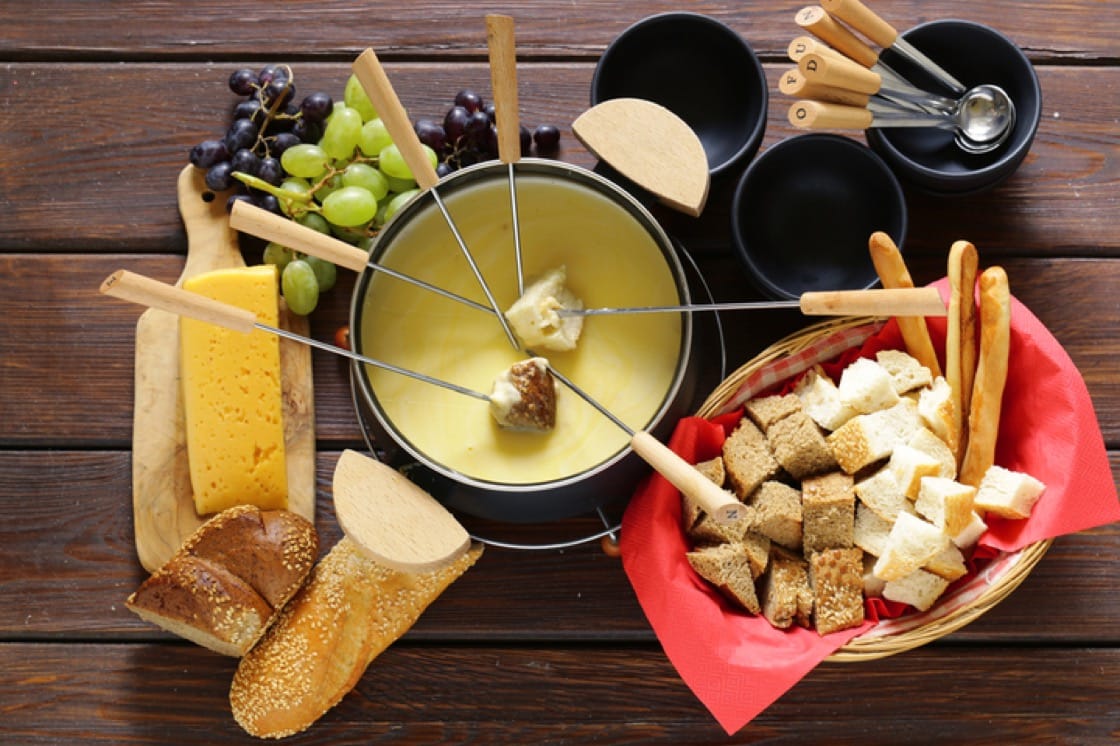
While the Swiss get all the credit for melty, velvety cheese fondue, the French have their own take on this Alpine dish, too.
Dear Stephane,
My cheese fondue keeps splitting. What’s the trick to getting it right and how can I dress up my fondue for a dinner party?
A cheese fondue is made up of a few key components and if you follow these tips, it’s not difficult to make a nice one to share with friends. This is the basic recipe:

Cheese Fondue
150g Gruyère
150g Beaufort
150g aged Comte
250ml dry white wine
3 tbsp cornstarch
2 cloves garlic
Black pepper
Nutmeg powder
Method:
1. Rub the inside of a cheese fondue pot or medium enamelled cast-iron casserole with the garlic clove and then discard the garlic.
2. Combine the grated Gruyère, Beaufort and Comté cheeses with the wine and cornstarch in the fondue pot and cook over moderate heat, stirring occasionally, until the cheeses begin to melt, about 5 minutes.
3. Add a generous pinch each of pepper and nutmeg, and cook, stirring gently, until creamy and smooth, about 10 minutes; don’t overcook the fondue or it will get stringy. Serve at once.
Types Of Cheese To Use
The best cheeses to use for cheese fondue are Gruyère AOP, Emmentaler AOP, Vacherin Fribourgeois AOP, or a blend of these three. Fondue comes from Switzerland, so these Swiss cheeses definitely work well. Gruyère is most commonly used for fondue, but it is expensive and very strong tasting, so I recommend using a blend of cheeses.

Emmentaler AOP lends a lovely nutty flavour, while I like Vacherin Fribourgeois AOP for its floral richness. All together, they give the perfect texture, acidity, and taste that is needed for a delicious fondue. You can also use French cheeses like Beaufort and aged Comte; these give a different taste that’s just as amazing.
Use Wine Or Chicken Stock
One of the essential ingredients for fondue is wine. You can use any dry, tart white wine in your fondue. Wine naturally contains tartaric acid which prevents the cheese’s casein proteins from clumping together when you melt it into the fondue. If you don’t take alcohol, you can replace the white wine with chicken stock. In both cases, I always like to add some cornstarch or potato starch to stabilise the cheese fondue.
Watch Out For the Heat
You need to be very gentle on the heat — fondue cannot be brought to a boil, otherwise it will split. Too low a temperature and the cheese will not melt properly. If you don’t have a fondue pot to control the temperature precisely, you can use a double boiler so that the heat is gentle on the fondue. Using a fondue pot to serve fondue at the table is helpful, since the fondue will thicken as it begins to cool down. Loosen up a set fondue by adding another splash of wine or stock.

Be Adventurous With Flavours
The tradition is to use garlic, and sometimes a bit of Kirsch (cherry brandy), to flavour the fondue, but you can be more adventurous. You can experiment with different types of cheese — I find blue cheese adds a very interesting dimension — or add a dash of nutmeg to your fondue. You can also try adding fresh tomato compote, a confit of shallots, or mushroom duxelles (chopped mushrooms sautéed with shallots and herbs).
You can dip a lot of different ingredients into your fondue. Just remember to pre-cook them. Here are some ideas:
- Good sourdough bread, cut into cubes
- Thinly sliced dried or cured beef
- Boiled baby potatoes
- Broccoli or cauliflower florets
- Paris button mushrooms
- Carrots
- Chicken, pork, or beef steak cubes
- Cut fruit like apple or pear
- Cooked white ham
- Large pasta tubes like manicotti, paccheri, or large fusilli
This article was first published in 24 October 2018 and updated on 08 February 2022.
















